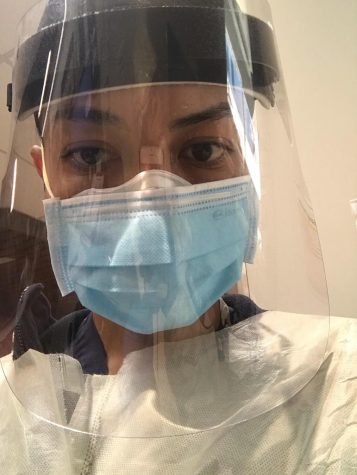Day in the Life of a Nurse during COVID-19
A look at what a regular day working in a hospital looks like
February 1, 2021
Working in a hospital during COVID has been looking a bit different for ICU Registered Nurse Sandra Tapia. Here’s a look at a typical day in the hospital:
5:44-6:45 am: Registered Nurse Sandra Tapia wakes up, puts on scrubs, gets ready, makes a large coffee, and leaves for work. Tapia arrives at work around 6:45 am; she walks from the parking lot to unit 3 west and clocks in. She then places personal belonging into a locker and grabs another cup of coffee. “Coffee is a nurse’s best friend,” said Tapia.
6:45-7:00 am: Nurse Tapia walks into the board room and negotiates a fair assignment -your assignment is who your patients will be for the day. Depending on your assignment your day will either run smoothly or it will be stressful.

If she has a patient infected with COVID-19 she must take extra precautions when caring for them. Before entering the patients’ room Tapia must be wearing a mask, a helmet that filters the air, a gown on top of surgical scrubs that she is borrowing from the hospital, and two pairs of gloves. She does whatever is necessary for the patient to be comfortable and cared for. If she forgot something or needs something from outside the room, she will look out the window to see if someone else can help, if no one is there she will press the call light. Once someone comes she will write what she needs on a whiteboard, the other nurse will bring it to her. Sometimes she is in there for an hour. When she leaves the room, she takes everything off, washes her hands, gets a new mask. If she notices something is going wrong again, like if the ventilator starts beeping, she has to put everything back on and go back in there, then she realizes she needs something from the outside, making finishing on time very hard.
7:30 am-9:30 am: Tapia describes these two hours as being a big blur. “There is no particular order to the events, it all depends on what is happening with your patient/s in these two hours I have to literally assess my patient from head to toe; I also have to gather information from my patient’s electronic medical record and know what the medical plan is, what had been done, what needs to be done, and what will be done to the patient,” Tapia said. “I have to know how much fluid we’ve given; how much urine they put out; the last time they pooped; and if they know their name, the year, the place.”
10:30- 12:30 pm: This is the time when things settle down a bit so Tapia gets to use the restroom and grab another cup of coffee. “If things are going smoothly I usually chart my assessment, because if you didn’t chart it, it didn’t happen and you need to chart like one day it may be read in a court,” said Tapia. (charting is the term used when referring to documentation)
12:30-3:30 pm: Tapia will continue to give medicine and care for patients as they need it, around this time Tapia will go on her 45 min break, where she usually buys a tuna sandwich from the cafeteria, goes to the restroom, and sits down for the first time in the entire day. Tapia says she also sends her daughter memes and checks in on her.
3:30 pm: Tapia plans for the last four hours of her shift.
Tapia says that if she has one of the most critical patients, she hopes they don’t go into code blue. She explains that if this happens these are the steps taken:
- She will notice it is about to happen
- She calls code blue, hits the button and the speaker says CODE BLUE ICU ROOM (whatever room it is in)
- If it is your patient you are in there doing compressions, if it is not your patient you run to the room and help
- One nurse records what happening, someone grabs a crash cart that has medication and a defibrillator (the machine medical professionals use to shock patients) a doctor is there and he/she leads the code, and every nurse is in charge of one thing.
- Once the patient is stabilized after the code blue, she is back to charting.
7:30-8:30: By this time Tapia hopefully has finished everything so she can go home after her shift at 7:30, if not she needs to stay to finish up. She then drives home, gets ready for bed, and rests until she wakes up the next morning at 5:44 am to do it all over again.

